Ostrava
The third largest city in the Czech Republic, is located in the northeastern part of the country and is the heart of the Moravian-Silesian Region. It is situated near the Slovak and Polish border on the banks of the Ostravice River overlooking the beautiful mountains of Beskydy.
The first mention of the village owned by the Olomouc Bishop Bruno is from 1267. The town was founded on the so-called Amber Route, which was used by merchants from ancient times as the main route connecting the Baltic Sea and the Mediterranean Sea.

Ostrava – beginning of 19th century
In the second half of the 14th century, town walls were built and the town castle was probably a part of the fortifications. Today the wall appears just in the name of a street - Na Hradbách - and as a fragment near the St. Wenceslas Church. Over the centuries, the town experienced numerous fires and military incursions, but also the heyday of trade and crafts.
The discovery of coal in the 2nd half of the 18th century, which was later followed by the development of ironworks, meant a breakthrough. Ostrava has long since lost the face of a typically industrial city and coal mining finally ended in 1994. Where there were originally mines, there are mining museums now and there is an opportunity waiting for a number of still sealed metallurgical buildings.
The city of Ostrava and its citizens are proud on their industrial heritage. It is a unique jewel of this city. Besides technical heritage the city offers its visitors many cultural and historical attractions, as well as other sights that allow people to enjoy a pleasant day full of unforgettable experiences. Ostrava is a part of important transportation arteries and is easily accessible by road and rail network, including air transport. The offer of accommodation and catering facilities will satisfy the needs and wishes of even the most demanding visitor.
You can look forward to comfort and care which will remain in your memory long after returning home. The traditional Czech hospitality is legendary, as well as excellent cuisine. You will fall in love with the taste and aroma of known and unknown dishes and specialties that are typical of this region.
What to see & do
Landek Park
Permanent exhibition of the Coal Mining Museum, recreation area. Located on the former Anselm Mine (one of the first to be established at the end of the 18th century in what is today the Petřkovice District of Ostrava), the Mining Museum was opened in the early 1990’s. A unique exhibition of the Mining Museum highlights the evolution of coal mining in the Ostrava-Karvina region, as well as mining technology, and rescue services. In fact, it is the largest exhibition of its kind in the world. With the collection of miner’s lights and hand tools, visitors get a real taste of the hard work and dedication the men of the mines had. The tour includes a view of mining in the original seams with wooden braces, mining machines and belt conveyors. The seams were often so narrow, that miners had to work lying down.
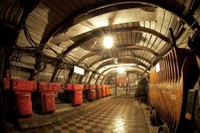 |
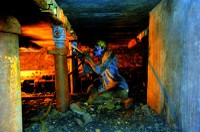 |
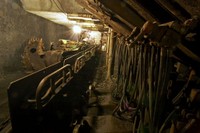 |
Big world of technology – Science and technology center
Science and technology center offers to its visitors hundreds of funny attractions which will entertain and educate them in many different fields of life, natural and technical sciences. There are four “Worlds” prepared for the visitors to let them discover the magic of connection between the science and nature on the area of 14.000 square meters. You can also find 3D cinema and Show & Demo Room inside the science center. The common denominator of all Worlds is to learn through fun and games. Visitors can discover the way the city or human body works, they can explore universe or reach the top of the tree here. The older ones can immerse themselves in the secret of cloning, learn a lot of about the micro and nano world and many more. Every researcher will be scanned by the mood detector which knows easily how does he feel today and if he is having fun. In addition, you can enjoy awesome supporting program during the weekend. There are also shows full of experiments and explosions in the Show & Demo room, games with mobile phone controlled robots, flying fish “Air Swimmers”, adrenaline ride in gyroscope and 3D films about flying dinosaurs, mammoths and ice age, wolves or coral reef inhabitants.
Small world of technology U6
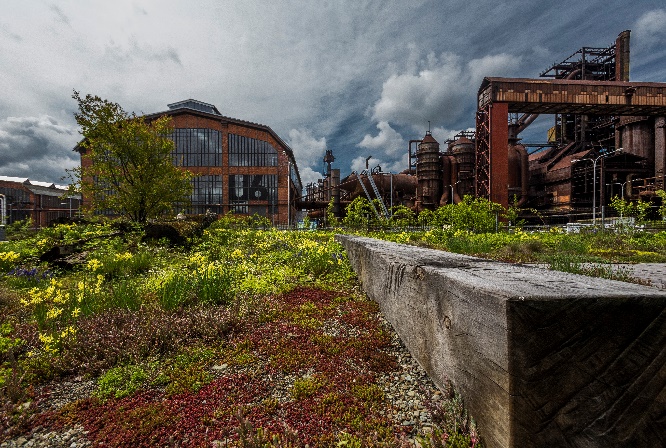 A unique exhibition reveals the secrets of technical inventions from the steam engine to the present. Visitors can find here a large number of inventions that significantly affected the development of industry and technological progress not only in the Czech lands but also in the world. Two huge piston blowers are the headliners of the exhibition. Every single one of them weights nine hundred tons. They bring out the patina of time as they are from 1938 and 1948. These giant blowers are surrounded by more than a hundred interactive exhibits which move, talk and – what’s the most important – entertain both young and old visitors. These exhibits show science and technology as visitors probably don’t know them: as a fun and game. Visitors can make a first-hand experience with the technical and scientific laws here, instead of learning complicated theories and formulas from boring textbooks. They can try to drive a train, to pilot a plane, experience how does it feel to work as a smelter in a factory, to be a space astronaut or Captain Nemo, who dives deep into the sea with his submarine. A topic, which on the first sight looked complicated, becomes logical and clear due to the game.
A unique exhibition reveals the secrets of technical inventions from the steam engine to the present. Visitors can find here a large number of inventions that significantly affected the development of industry and technological progress not only in the Czech lands but also in the world. Two huge piston blowers are the headliners of the exhibition. Every single one of them weights nine hundred tons. They bring out the patina of time as they are from 1938 and 1948. These giant blowers are surrounded by more than a hundred interactive exhibits which move, talk and – what’s the most important – entertain both young and old visitors. These exhibits show science and technology as visitors probably don’t know them: as a fun and game. Visitors can make a first-hand experience with the technical and scientific laws here, instead of learning complicated theories and formulas from boring textbooks. They can try to drive a train, to pilot a plane, experience how does it feel to work as a smelter in a factory, to be a space astronaut or Captain Nemo, who dives deep into the sea with his submarine. A topic, which on the first sight looked complicated, becomes logical and clear due to the game.
World of Technology in Lower Vítkovice Area is the best family entertainment for the weekend!
Stodolní street
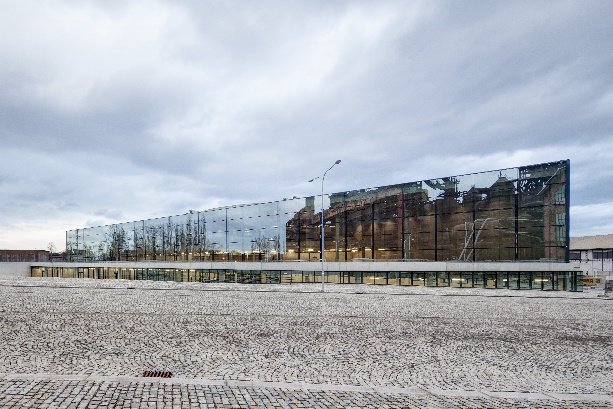 The street that never sleeps. This is the way Stodolní Street in the city centre is referred to. Originally a place where there were barns. The first mention of a barn dates back to 1543. From the 1880s until 1945, the barns were rebuilt into brick buildings. In 1995, the now legendary club Černý pavouk (Black Spider) was founded there and Stodolní became a street that truly never sleeps. Sixty clubs, cafés, pubs, bars, restaurants and several hotels makes this street an attractive place to meet friends. Parties at Stodolní became a legend long ago...
The street that never sleeps. This is the way Stodolní Street in the city centre is referred to. Originally a place where there were barns. The first mention of a barn dates back to 1543. From the 1880s until 1945, the barns were rebuilt into brick buildings. In 1995, the now legendary club Černý pavouk (Black Spider) was founded there and Stodolní became a street that truly never sleeps. Sixty clubs, cafés, pubs, bars, restaurants and several hotels makes this street an attractive place to meet friends. Parties at Stodolní became a legend long ago...
“The Ostravar” brewery museum and company
The history of the Ostravar Brewery dates back to 1842, with the completion of the first brewing hall, and malt room on Brewery Street (Pivovarská ulice) in the centre of Ostrava. The Brewery supplied beer mostly to local German pubs. On December 11, 1896, a license to build a Czech Brewery was granted. It was opened on Hornopolní Street on May 16th, 1898, and a year later a restaurant was opened on the premises. The Brewery was a success. In 1907, it joined the Association of Moravian Breweries and Malt Plants. In 1940, it was merged with the Strassmann Brewery and renamed Moravian-Ostrava Breweries. It was partially damaged in World War II and then repaired. In the 1960's, it went under further repair. At the end of the century, new brewing technologies were installed, and ownership changed hands. Since the end of the year 2000, a majority stake of Prague Breweries (owner of Ostravar) was bought by Interbrew Central European Holding.
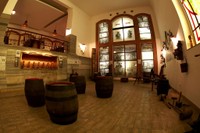 |
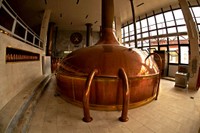 |
 |
In the Ostravar brewery, an excursion route has been traced for visitors, who will be able to learn interesting things about the brewing of the Czech national drink. At the end of the route, visitors can taste their favourite brew. A great attraction of the Museum is a tap bar that is more than 60 years old. In addition to the tap-room, visitors can see a number of other interesting objects linked with brewing. There are, for example, specimens of barrels with illustrations of how they were made, transport glasses dating from the 1920s and 1930s and a historical barrelhead. All this is accompanied by historical photographs and labels.
The Gallery of Graphic Arts - The House of Arts
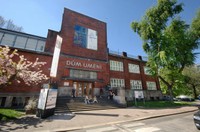 The House of Fine Arts is an architectural gem. It contains the city's only permanent collection. Since 1990, a large number of smaller, generally private galleries and exhibition halls have opened, complementing Ostrava's largest and oldest gallery.
The House of Fine Arts is an architectural gem. It contains the city's only permanent collection. Since 1990, a large number of smaller, generally private galleries and exhibition halls have opened, complementing Ostrava's largest and oldest gallery.
Today's Gallery of Graphic Arts, located in Ostrava's House of Fine Arts has a wide variety of works in its collection, including a valuable series of European art, Czech art from the 19th and 20th centuries, a unique collection of 20th century Spanish art, works from the so-called Paris school, a collection of Russian realists, a rich graphic arts collection, and more. The collection is regularly up-dated with new acquisitions. In addition to their own permanent collections the gallery host exhibitions presenting the works of other important artists.
The Ostrava Zoo
 The Ostrava Zoo was founded in 1951. It covers an area of 100 ha and is the home to 360 different species of animals. African hoofed animals (giraffes and zebras), predators and parrots, chimpanzees, lemurs, elephants, rhinoceroses and many other interesting animals attract large numbers of visitors.
The Ostrava Zoo was founded in 1951. It covers an area of 100 ha and is the home to 360 different species of animals. African hoofed animals (giraffes and zebras), predators and parrots, chimpanzees, lemurs, elephants, rhinoceroses and many other interesting animals attract large numbers of visitors.
In place of the original children's Zoo a new pavilion with domestic animals was erected. The biggest construction project of 2010 is undoubtedly the "Citvan" exposition - a large complex for Asian black bears and Northern plains gray langurs with an additional pavilion for Asian small-clawed otters as well as two large aquariums housing fishes of Nepali rivers.
2011 saw the opening of the new hippo pavilion and the new Papua pavilion showcasing reptiles and fishes is coming up soon. The area of the old bear pit which is to be pulled down will in the future be utilized for a construction of a new modern exhibit giving home to species attractive to visitors and so far unseen in Ostrava Zoo - penguins and seals.
The Silesian - Ostrava Castle
The Silesian Ostrava Castle is the city's most historic cultural monument. It was built in the second half of the 13th century, close to the confluence of the Lučina and Ostravice rivers, where a fortified Slavonic settlement had once stood. Originally built for military purposes, it served as a defensive stronghold against the Moravian Lands on the Polish border, stretching from Opava, through Hlučín and Krakow to Těšín. Its importance is borne out by the fact that it was enclosed by a 4-m high and 2.5-m broad wall as early as the 13th century. In 1534, the Gothic castle was rebuilt into a Renaissance chateau, and traces of this alteration can still be seen in parts of the ruin and in the design of the interior. In 1872, the castle burnt down, but was later re-built. The main cause of its destruction was coal-mining, with seams worked directly beneath the castle. The whole structure sank 16 m into the ground!
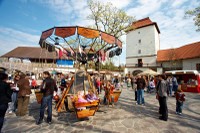 |
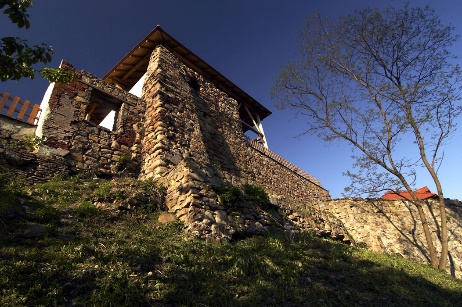 |
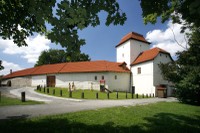 |
The original two-storey palace structure with its protective wall system has been preserved to this day. The castle has been reconstructed and visitors now can view in its interior several permanent exhibitions telling the history of the building and the city of Ostrava, an exhibition of torture instruments, the castle’s vaulted cellars with witches, fresh-water fish aquaria and the castle gallery. Castle smithy can be found in the stone niche near the courtyard.
The world of miniatures – miniuni
The Miniuni is an interesting attraction for both children and adults. Spread out over 1.5 hectares visitors can see more than 30 models of significant buildings of European cities, like Big Ben, Old Town Hall or one of the best-known landmarks of Berlin the Brandenburg Gate, all dominated by the 12 metre-high Eiffel tower. The models are built at a scale of 1:25. Recently added are the Wonders of the Ancient Times. There are railway lines with little trains running across the grounds and waterways with a steamship. Special exhibitions and entertainment events for children are organized here regularly. The restaurant invites visitors for rest and refreshment offering them specialities of European cuisine.
 |
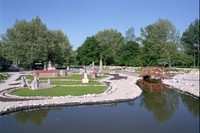 |
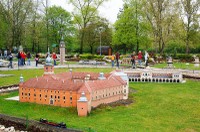 |
Ostrava’s watchtowers
There are three the most popular watchtowers at Ostrava.
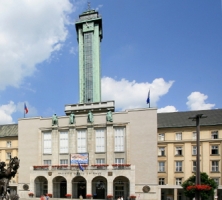 The Viewing Tower of the New city hall is one of the city's most popular tourist attractions. On a clear day, it is possible to see the entire city, the nearby Beskydy Mountains, and even neighbouring Poland. The Viewing Tower has dominated the Ostrava skyline since it was built at the New City Hall (the largest in the Czech Republic) in 1930. The strict functionalist style of the tower creates, in the opinion of its designers, a noble beacon of concrete, metal and glass. The tower reaches 298.05 metres above sea level, or roughly 85.60 metres above ground level. The tower is equipped with an illuminated clock face, an elevator, and a lookout deck 72 metres above the ground.
The Viewing Tower of the New city hall is one of the city's most popular tourist attractions. On a clear day, it is possible to see the entire city, the nearby Beskydy Mountains, and even neighbouring Poland. The Viewing Tower has dominated the Ostrava skyline since it was built at the New City Hall (the largest in the Czech Republic) in 1930. The strict functionalist style of the tower creates, in the opinion of its designers, a noble beacon of concrete, metal and glass. The tower reaches 298.05 metres above sea level, or roughly 85.60 metres above ground level. The tower is equipped with an illuminated clock face, an elevator, and a lookout deck 72 metres above the ground.
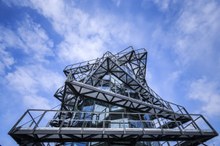 The Bolt tower: A café, an exhibition space, a clubroom and a terrace with stunning panoramic views – all these great new attractions can be found in the new extension at the top of blast furnace no. 1, part of the Lower Vítkovice industrial heritage complex. The extension is a tower which spirals upwards adding an extra 25 metres to the blast furnace – making it the highest geographical point in the whole of Ostrava (77.7 metres above ground level) and creating a striking new landmark. The glass-walled tower offers visitors a bird’s eye view of the city and the surrounding area from a height of 71 metres.
The Bolt tower: A café, an exhibition space, a clubroom and a terrace with stunning panoramic views – all these great new attractions can be found in the new extension at the top of blast furnace no. 1, part of the Lower Vítkovice industrial heritage complex. The extension is a tower which spirals upwards adding an extra 25 metres to the blast furnace – making it the highest geographical point in the whole of Ostrava (77.7 metres above ground level) and creating a striking new landmark. The glass-walled tower offers visitors a bird’s eye view of the city and the surrounding area from a height of 71 metres.
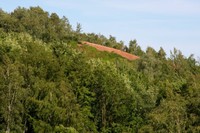 Ema slag heap: It was gradually formed by piling up the Trojice mine waste rock and has become a popular destination for trip makers. It features an area of 82 hectares and more than 4 million tons of waste rock. . It is the highest point of the city with its peak reaching 334 metres. In the sixties, ignition occurred inside the slag heap and the fire has been burning ever since. The inside temperatures can reach up to 1,500°C which allows species of plants and animals typically found in prairies to be abundant in its vicinity. These extreme temperatures resulted in occurrence of precious minerals inside this natural curiosity. The tourist trail to the slag heap is marked yellow. Along the trail are 12 information panels describing the natural, cultural and technical attractions found around it and in the area of Slezská Ostrava.
Ema slag heap: It was gradually formed by piling up the Trojice mine waste rock and has become a popular destination for trip makers. It features an area of 82 hectares and more than 4 million tons of waste rock. . It is the highest point of the city with its peak reaching 334 metres. In the sixties, ignition occurred inside the slag heap and the fire has been burning ever since. The inside temperatures can reach up to 1,500°C which allows species of plants and animals typically found in prairies to be abundant in its vicinity. These extreme temperatures resulted in occurrence of precious minerals inside this natural curiosity. The tourist trail to the slag heap is marked yellow. Along the trail are 12 information panels describing the natural, cultural and technical attractions found around it and in the area of Slezská Ostrava.
Ostrava surroundings
Castles
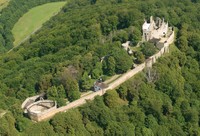 The Gothic Hukvaldy Castle, one of the largest in Central Europe and the third largest in the Czech Republic, dates back to the 13th century. The Castle grounds are carefully taken care of these days. Concerts are held in the Baroque castle's chapel, and outdoors between the castle walls, especially in June and July when the town hosts the Janáček's Hukvaldy International Music Festival, begun in 1993. Some concerts take place in the natural amphitheatre with its beautiful surroundings -- a tourist attraction all four seasons of the year. The Festival honours Leoš Janáček, who was born in Hukvaldy, and often spent time there in later life. His home, at number 79, has become a local monument. Janáček's well-known Opera "The Cunning Little Vixen" was largely inspired by the surroundings of Hukvaldy, especially its forests.
The Gothic Hukvaldy Castle, one of the largest in Central Europe and the third largest in the Czech Republic, dates back to the 13th century. The Castle grounds are carefully taken care of these days. Concerts are held in the Baroque castle's chapel, and outdoors between the castle walls, especially in June and July when the town hosts the Janáček's Hukvaldy International Music Festival, begun in 1993. Some concerts take place in the natural amphitheatre with its beautiful surroundings -- a tourist attraction all four seasons of the year. The Festival honours Leoš Janáček, who was born in Hukvaldy, and often spent time there in later life. His home, at number 79, has become a local monument. Janáček's well-known Opera "The Cunning Little Vixen" was largely inspired by the surroundings of Hukvaldy, especially its forests.
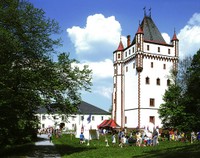 The quality of the architecture of the castle at Hradec nad Moravicí, located on 60ha of parklands, as well as its collection of historic art pieces, places it among the most sought-after tourist sites in the region. It is known as an important centre of culture that holds exceptional events annually. Since 1962, it has played host to the Beethoven's Hradec Music Competition every June. The public were re-admitted to the castle in May, 1949. In 1979, a general repair was begun, in 1996 parts of the castle were again opened to the public. Today, it's possible to tour the luxury of the salons and comfort of the guest apartments. The gallery contains some of the original treasures of the castle, both paintings and historical pieces. The exhibition hall presents current artistic works from the region. Concerts are also held in the courtyard and inside the castle, and are among the most enthusiastically received in the region. There is also a restaurant.
The quality of the architecture of the castle at Hradec nad Moravicí, located on 60ha of parklands, as well as its collection of historic art pieces, places it among the most sought-after tourist sites in the region. It is known as an important centre of culture that holds exceptional events annually. Since 1962, it has played host to the Beethoven's Hradec Music Competition every June. The public were re-admitted to the castle in May, 1949. In 1979, a general repair was begun, in 1996 parts of the castle were again opened to the public. Today, it's possible to tour the luxury of the salons and comfort of the guest apartments. The gallery contains some of the original treasures of the castle, both paintings and historical pieces. The exhibition hall presents current artistic works from the region. Concerts are also held in the courtyard and inside the castle, and are among the most enthusiastically received in the region. There is also a restaurant.
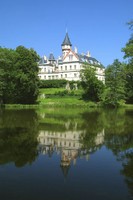 Few castles fit in with their surroundings so picturesquely as the Raduň castle 25 kilometres from Ostrava. In the 16th century, a large reconstruction turned this small medieval fort into a comfortable Renaissance residence. The grounds of the castle include a wood, three ponds, a brewery, a malt house, and barns. During the Thirty-Years' War, the castle was plundered and the residence abandoned. The tour of the Raduň castle interiors takes visitors through attractively furnished private rooms of the princely apartment and social salons tracing the changes of the life style of the aristocratic family in the rural countryside. The tour covers the Castle Library with nearly 16 000 volumes and the beautiful park surrounding the Castle, marked for the exquisite composition of the trees and its dendrological qualities. It is one of the most important protected landscape systems of the Moravian-Silesian Region. Its special features are an empire sheep-fold, an orangery and Renaissance granaries.
Few castles fit in with their surroundings so picturesquely as the Raduň castle 25 kilometres from Ostrava. In the 16th century, a large reconstruction turned this small medieval fort into a comfortable Renaissance residence. The grounds of the castle include a wood, three ponds, a brewery, a malt house, and barns. During the Thirty-Years' War, the castle was plundered and the residence abandoned. The tour of the Raduň castle interiors takes visitors through attractively furnished private rooms of the princely apartment and social salons tracing the changes of the life style of the aristocratic family in the rural countryside. The tour covers the Castle Library with nearly 16 000 volumes and the beautiful park surrounding the Castle, marked for the exquisite composition of the trees and its dendrological qualities. It is one of the most important protected landscape systems of the Moravian-Silesian Region. Its special features are an empire sheep-fold, an orangery and Renaissance granaries.
The Beskydy mouintains
 Only 25 kilometres separate Ostrava from the lower slopes of the Beskydy Mountains, lying along the borders of the Czech Republic, Slovakia, and Poland. The Beskydy have been the main recreational getaway for the people of Ostrava for decades. Many mountain settlements are surrounded by recreational cottages. Lysá hora (1.324m), the highest mountain in the Beskydy range is veiled in fable and myth. Tourists love the gentle rolling hills of the Beskydy Mountains. The area is resplendent with hundreds of kilometers of trails, through secluded valleys, deep coniferous forests, around mountain streams, and large quiet dams. The mountain cottages welcome cyclists and moto-tourists. The Beskydy bike map offers tourists hundreds of kilometers of cycling routes. From May to September, there is a cyclo-bus from Ostrava.
Only 25 kilometres separate Ostrava from the lower slopes of the Beskydy Mountains, lying along the borders of the Czech Republic, Slovakia, and Poland. The Beskydy have been the main recreational getaway for the people of Ostrava for decades. Many mountain settlements are surrounded by recreational cottages. Lysá hora (1.324m), the highest mountain in the Beskydy range is veiled in fable and myth. Tourists love the gentle rolling hills of the Beskydy Mountains. The area is resplendent with hundreds of kilometers of trails, through secluded valleys, deep coniferous forests, around mountain streams, and large quiet dams. The mountain cottages welcome cyclists and moto-tourists. The Beskydy bike map offers tourists hundreds of kilometers of cycling routes. From May to September, there is a cyclo-bus from Ostrava.


